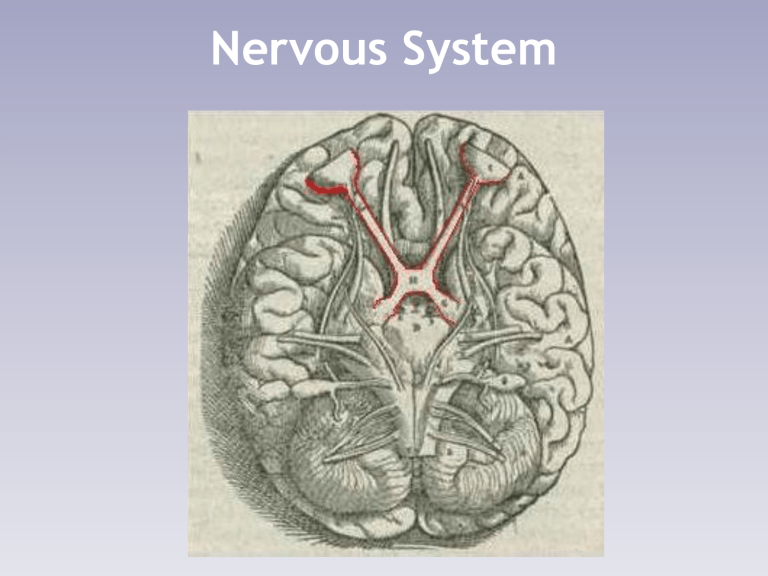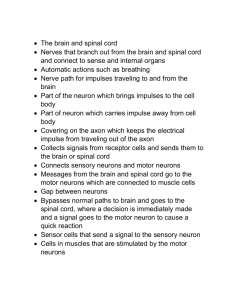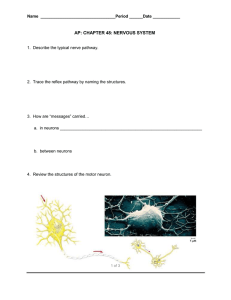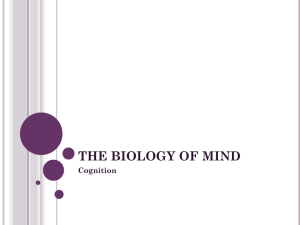Nervous System
advertisement

Nervous System Functions of the Nervous System • Detection of changes in and outside the body. • Integration of information from each of the senses. • Coordination of muscles, organs, and glands. Divisions of the Nervous System • The Central Nervous System (CNS) includes the brain and spinal cord. • The Peripheral Nervous System (PNS) is all the nervous tissue outside of the brain and spinal cord. ▫ The afferent division transmits information from the senses towards the brain. ▫ The efferent division transmits commands to the muscles and glands from the brain. • The efferent division of the PNS is divided into two systems: ▫ The somatic nervous system (SNS) controls skeletal muscle. ▫ The autonomic nervous system (ANS) regulates involuntary smooth and cardiac muscle, as well as glands. The sympathetic division includes “fight or flight” responses. The parasympathetic division includes “rest and digest” responses. CENTRAL NERVOUS SYSTEM Brain and spinal cord Afferent Division PERIPHERAL NERVOUS SYSTEM Efferent Division Somatic nervous system Autonomic nervous system Parasympathetic division Somatic sensory receptors Visceral sensory receptors Skeletal muscle Sympathetic division Smooth muscle Cardiac muscle Glands Neural Tissue • Neurons are the basic units of the nervous system, able to communicate with other cells. • Neuroglia support neurons by regulating their surrounding environment. Cell Body Nucleus Myelin Sheath Node Neuroglia (produces myelin) Axon Dendrites Axon Terminals Neurons • Neurons are cells specialized in transmitting and receiving messages. ▫ Dendrites receive incoming signals. ▫ Axons conduct impulses away from the cell body. ▫ The cell body contains the neuron’s organelles. • Neuron axons have myelin, thin pads of lipids that serve as electrical insulation. ▫ Myelinated neurons can transmit electrical signals much faster, and appear white. • Demyelination is a progressive destruction of myelin sheaths, causing a loss of sensation and motor control. ▫ Examples include multiple sclerosis (MS) and mercury poisoning. How Do Neurons Send Signals? • Nerve signals begin with a stimulus is required before a nerve impulse begins – either from another neuron or from one of the senses. How Do Neurons Send Signals? • Nerve signals are electrical impulses sent across the membrane of neurons called action potentials. • The electrical impulses are generated by changing amounts of ions inside and outside the neuron. ▫ ▫ ▫ ▫ Potassium, K+ Sodium, Na+ Chlorine, ClNegative-charged proteins, Pr- Neuron Polarization • A resting neuron has a negative potential of about -70mV. ▫ This is the result of the proteins (Pr-) permanently kept inside the cell. • Depolarization occurs when a stimulus (such as a neurotransmitter) causes a protein channel to open. ▫ Na+ ions flood diffuse inside the cell membrane, creating a positive charge across the membrane.. • The next step is repolarization; the return to the original negative charge as K+ ions diffuse out of the cell. ▫ So much K+ leaves the cell that it becomes hyperpolarized, or more negative than its original resting state. • The sodium-potassium ATP pump restores the original concentrations of K+ and Na+ through active transport. ▫ The neuron is now able to conduct another action potential. Action Potential Summary Peak Action Potential Repolarization Depolarization Hyperpolarization Resting Potential Na/K ATP Pump Transmission at a Synapse • Eventually, the signal will reach the synapse; a gap between the axon of the neuron and another cell. ▫ A neurotransmitter is released from the axon of the previous neuron. ▫ The neurotransmitter passes through a gap called a synaptic cleft before reaching the next cell. • Cholinergic synapses are found between motor neurons and muscle cells. ▫ The neurotransmitter acetylcholine is released and binds to receptors on the muscle cell. ▫ Acetylcholine is eventually broken down by an enzyme, ending the process. • Botulism is a disease caused by the ingestion of bacterial toxins from rotting food. ▫ The toxin prevents the release of acetylcholine at cholinergic receptors, causing paralysis. • Tetanus is caused by a bacterial toxin that inhibits the enzyme that breaks down acetylcholine. ▫ This causes prolonged, painful muscle contractions. ▫ Exposure to the bacteria is through any would that punctures the skin. Neuron Classification • Sensory neurons receive information from the peripheral nervous system or special senses. ▫ Somatic receptors detect information from the outside world. ▫ Visceral receptors monitor conditions within organs such as the lungs, stomach, etc. • Motor neurons carry signals from the central nervous system to muscles or organs. ▫ Somatic motor neurons innervate voluntary skeletal muscles. ▫ Autonomic motor neurons innervate all involuntary muscles, including the heart (cardiac), glands, and hollow organs (smooth). • Interneurons join other neurons together. Reflexes • A reflex is a rapid, involuntary response to a stimulus. ▫ These actions occur more quickly because they occur over a reflex arc, a pathway that bypasses the brain. The Reflex Arc • A reflex arc begins with a stimulus at a sensory neuron, such as pain or heat. • The sensory neuron is depolarized, and the signal is sent through its axon. • The signal is processed by an interneuron in the spinal cord, which then activates a motor neuron. • A neurotransmitter is released at a cholinergic synapse. • The muscle contracts in response to the neurotransmitter, and the reflex is complete. External Brain Anatomy Central Sulcus Postcentral Gyrus Precentral Gyrus Parietal Lobe Frontal Lobe Parieto-Occipital Sulcus Occipital Lobe Lateral Sulcus Temporal Lobe Cerebellum Medulla Oblongata Pons Cerebrum • The adult brain has six major regions. • The cerebrum is the largest region, controlling conscious thought, complex movements, and memory. • The frontal lobe controls movement, language, and other higher-thinking functions. • The temporal lobe contains the auditory, taste, and olfactory areas. • The parietal lobe integrates sensory information. • The occipital lobe contains the vision center. Parietal Lobe Central Sulcus Parieto-Occipital Sulcus Frontal Lobe Occipital Lobe Corpus Callosum Pineal Gland Lateral Ventricle Hypothalamus Pituitary Gland Cerebellum Thalamus Pons Medulla Oblongata Layers of the Cerebrum • The cerebrum has two layers: ▫ Outer grey matter that contains neuron cell bodies. ▫ Inner white matter that contains axons encased in myelin sheaths. Diencephalon • The diencephalon integrates sensory information and motor commands. ▫ The thalamus transfers impulses received from sensory neurons to the correct region of the cerebrum. • The hypothalamus controls many aspects of internal homeostasis, including body temperature, water balance, and overall metabolism. • The pineal gland releases melatonin, a hormone that regulates day-night cycles. The Brain Stem • The brain stem directly attaches the brain to the spinal cord. ▫ The pons contains the neurons responsible for controlling breathing (along with the medulla). • The medulla oblongata is the lowest part of the brain stem, merging into the spinal cord. ▫ Controls heart rate, blood pressure, swallowing, vomiting, and breathing (with the pons). Cerebellum • The cerebellum coordinates posture, balance, and body movements. Protection of the CNS • Due to their size and complex shape, neurons cannot undergo mitosis and are irreplaceable. • As a result, the CNS has more protection than any other part of the body. Protection of the CNS • The first layer of protection are the flat bones of the skull. • Below the bone are the meninges, membranes of connective tissue. ▫ Dura mater is the outermost thickest layer. ▫ Arachnoid mater is a network of blood vessels. ▫ Pia mater is the innermost layer. Protection of the CNS • Cerebrospinal fluid, similar to plasma, circulates through a series of cavities called ventricles throughout the brain. ▫ Provides a watery cushion that protects nervous tissue from trauma. • A blood-brain barrier, made of capillaries, only allows water, glucose, and amino acids into the brain area. ▫ Wastes, proteins, and cells are kept out. Spinal Cord • The spinal cord is essentially a continuation of the brain stem down the back towards the pelvis. ▫ Bone, meninges, and cerebrospinal fluid provide protection. ▫ Spinal nerves are mixed nerves that carry motor, somatic, and autonomic signals to the body from the spinal cord. CNS Disorders • Encephalitis is an inflammation of the brain itself, caused by a foreign substance or a virus. ▫ Headache, drowsiness, nausea, fever. • Meningitis is an inflammation of the meninges (membranes) of the brain and spinal cord. ▫ Fever, stiff neck CNS Disorders • Alzheimer’s disease is a degenerative disease that causes a gradual loss of neuron cell bodies and synapses in the cerebral cortex. ▫ Tends to affect new memories first. ▫ Cause unknown. CNS Disorders • Brain tumors are masses of cells that overgrow in specific areas of the brain. ▫ Symptoms vary depending on the exact region affected by the tumor. CNS Disorders • A stroke occurs when a blood clot or ruptured blood vessel interrupts blood flow to a specific part of the brain. ▫ Brain cells die from lack of oxygen, causing permanent damage in that region. ▫ Brain equivalent of a heart attack. • A concussion is a traumatic brain injury caused by an impact that is not absorbed by cerebrospinal fluid and damages the brain itself. Cranial Nerves • The cranial nerves are 12 pairs of nerves, mostly from the head and neck, that attach directly to the brain. ▫ Bypass the spinal cord. ▫ Part of the autonomic nervous system. Cranial Nerves I. Olfactory ▫ Smell (sensory) II. Optic ▫ Vision (sensory) III.Oculomotor ▫ Eye muscles (motor) IV.Trochlear ▫ Eye muscles (motor) V. Trigeminal ▫ Facial (sensory) , chewing muscles (motor) VI.Abducens ▫ Eye muscles (motor) Cranial Nerves VII.Facial ▫ Taste (sensory), facial muscles (motor) VIII.Vestibulocochlear ▫ Balance and hearing (sensory) IX.Glossopharyngeal ▫ Taste (sensory), swallowing (motor) X. Vagus ▫ ▫ Sensory and motor neurons that affect sweating, peristalsis, heart rate, opening the larynx for speech and breathing. Has branches in the ear canal – cotton swab cough. Cranial Nerves XI.Accessory Nerve ▫ Neck and upper back muscles (motor) XII.Hypoglossal ▫ Tongue (motor)








